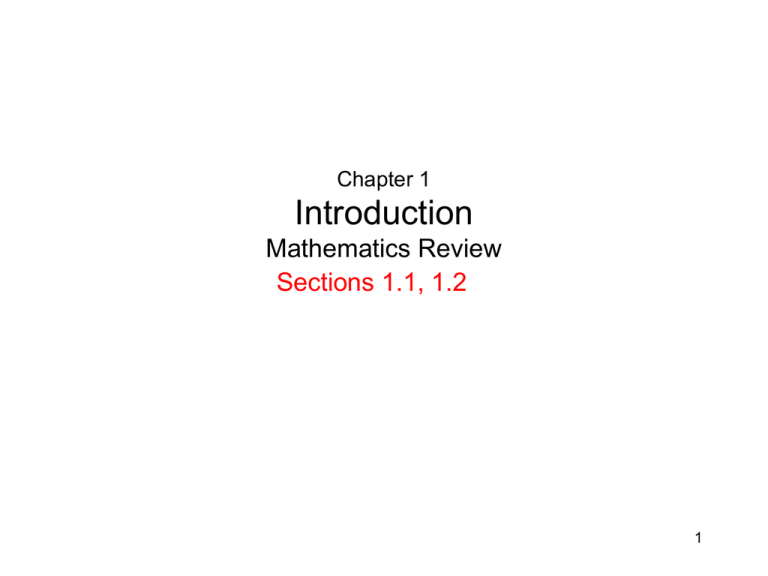Math Review
advertisement

Chapter 1 Introduction Mathematics Review Sections 1.1, 1.2 1 Outline • Why does program execution time for large inputs matter? • Basic mathematical background 2 Selection Problem • Find the kth largest number from a group of N numbers – How would you solve this? • Algorithm 1: – Sort the N numbers and pick the kth one. – Easy to implement, but • Sorting requires many comparisons • Much work comparing elements having no chance to be at position K – To sort N elements, need N log2(N) comparisons/swaps in general – An unsorted data set with 10,000,000 elements and 1,000 swaps/sec will take around 2 hours 3 Selection Problem (Cont’d) • Algorithm 2: (Better) – Sort first K elements in the array. – Then insert elements (K+1) to N, discarding the smallest element each time. – Then pick the kth element. • What if N=10 million and K=5,000,000? – How long do you think this would take? • Both algorithms are impractical. • A better algorithm can solve this in a second! 4 Mathematics Review • • • • • Exponents Logarithms Series Modular arithmetic Proof techniques 5 Exponents X A X B X A B XA A B X XB X A B X AB X N X N 2 X N X 2N 2 N 2 N 2 N 1 6 Logarithms • All logarithms are to the base 2, unless otherwise specified • Definition 1.1 – XA = B if and only if logxB = A 7 Properties of logarithms • Theorem 1.1 (base-change) – log A B log C B ; log C A A, B, C > 0, A 1 • Proof: Let X = logCB, Y = logCA, and Z = logAB – – – – Then: CX = B, CY = A, and AZ = B Implies: B = CX = (CY)Z = CYZ Hence: X = YZ And: Z = X/Y 8 Logarithms (contd.) • Theorem 1.2 – log(AB) = log A + log B; A, B > 0 • Proof: (Assume base 2) – Let: X = log A, Y = log B, and Z = log AB – Hence: 2X = A, 2Y = B, and 2Z = AB – Combining the above: 2Z = AB = 2X2Y = 2(X+Y) – Implies: X + Y = Z 9 Logarithms (contd.) • More results – – – – – – – log(A/B) = log A – log B log(AB) = B log A log X < X for all X > 0 log 1 = 0 log2 2 = 1 log2 1024 = 10 log2 1,048,576 = 20 10 Geometric Series N • 2 • A N 1 1 A A 1 i 0 i 2 N 1 1 i 0 N • i N If 0 < A < 1, • If N -> i A i 0 1 1 A , we have Ai i 0 1 1 A • How?? 11 Arithmetic Series • N ( N 1) N 2 i 2 2 i 1 N • How about 2+5+8+…+(3k-1) ? 12 Modular Arithmetic • We say that A is congruent to B modulo N – Written as A B (mod N) – If N divides (A-B) • In other words, the remainder is the same if either A or B are divided by N • E.g. – 81 61 1 (mod 10) • Similar to equality, if A B (mod N), then – A C B C (mod N), and AD BD (mod N) 13 Proof techniques • Two common proof techniques in data structure and algorithm analysis (and in CS, in general) – Proof by induction – Proof by contradiction – Another common technique • Proof a statement false with a counterexample 14 Proof by Induction • Given a theorem • First prove a base case – Show the theorem is true for some small degenerate values • Next assume an inductive hypothesis – Assume the theorem is true for all cases up to some limit k • Then prove that the theorem holds for the next value (k+1) 15 Proof by Induction - example • Fibonacci Series – F0 = 1, F1 = 1, Fi = F(i-1) + F(i-2), for i>1 • Show that – Fi < (5/3)i,for i>0 • Base case: – F1 = 1 < 5/3 – F2 = 2 < (5/3)2=25/9 • Inductive Hypothesis – Assuming: Fi < (5/3) i , i = 1, 2, ..., k 16 Proof by Induction - example (contd.) • Now prove that Fk+1 < (5/3)k+1 • From definition of Fibonacci Sequence – Fk+1 = Fk + Fk-1 • Using inductive hypothesis – Fk+1 < (5/3) k + (5/3) k-1 = (5/3) k+1 [ 3/5 + (3/5)2] = (5/3) k+1 [24/25] < (5/3) k+1 17 Other types of proofs • Disprove with a counter-example – The statement Fk k 2 is false in the Fibonacci series – Proof: F11 = 144 > 112 = 121 • Proof by contradiction – – – – Initially assume that the theorem is false Then show that some known property would be false as well. Example: “There is an infinite number of prime numbers” Proof: • Assume the theorem is false (so there are only finite prime) • Let P1, P2, ..., Pk be all the primes in increasing order. • Let N = P1P2 Pk + 1,N is > Pk , so it is not a prime • But it is also not divisible by any of the listed primes, contradicting the factorization of integers into primes. • We reach a contradiction 18





